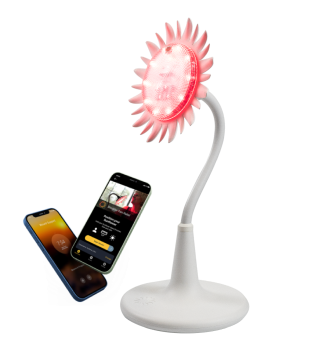
- Shop
- Learn
-
-
- Buy The Sunflower Now
Feel the difference
Get Started with JustLight
Sunflower is the most advanced light therapy available today.

-
- Collaborate
- Blog
- Quiz
- My Account
Free Shipping in the 48 States!
We’ll explore how at-home phototherapy works, the skin types it benefits, the different types of UV light, and how to safely incorporate UVB Phototherapy into your treatment routine.
Buy Sunflower TodayPhototherapy, traditionally associated with clinical treatments, is now available as an at-home option for managing a range of skin conditions such as psoriasis, eczema, and vitamin D deficiency. With advancements in light therapy devices, people can now access these treatments without needing frequent visits to a phototherapy clinic. In this guide, we’ll explore how phototherapy light at home works, the benefits for different skin types, and how the Sunflower by JustLight stands out as the superior option compared to other devices like SolRx.
Phototherapy utilizes specific wavelengths of light, particularly ultraviolet (UV) light, to treat various skin conditions. The light penetrates the skin, slowing the rapid growth of affected cells and reducing inflammation, redness, and irritation. UVB Phototherapy, which uses narrowband UVB light (311-313 nm), has proven effective for treating conditions like psoriasis, vitiligo, and atopic dermatitis. While natural sunlight contains UV light, phototherapy delivers controlled, targeted wavelengths, offering a more precise and effective treatment.
The Sunflower by JustLight, however, goes beyond UV phototherapy. It offers a wide spectrum of light therapies, including red light and near-infrared light, tailored to specific skin conditions, making it one of the most versatile devices on the market.
For those managing chronic skin conditions, phototherapy light at home treatments provide unmatched convenience. Devices like the Sunflower enable users to undergo light therapy in the comfort of their homes, saving time and frequent visits to a hospital setting or phototherapy clinic. Unlike traditional phototherapy units, which focus solely on UV light, the Sunflower incorporates both low-level laser therapy and near-infrared light, offering a more comprehensive treatment option for skin health, collagen production, and joint pain relief.
The Sunflower provides all-in-one treatment, using a smart app that customizes light therapy sessions based on your unique skin needs and health goals. Whether you’re treating skin conditions or looking for pain relief, the Sunflower offers a tailored, effective solution that fits into your daily routine.
While many devices like SolRx offer UVB light therapy for skin conditions, the Sunflower provides a far more advanced, all-encompassing solution. Here’s why:
UVB light is commonly used in traditional phototherapy to treat skin conditions like psoriasis and eczema. However, red light and near-infrared light offer additional benefits by promoting collagen production, increasing blood flow, and reducing inflammation. Unlike UV light, red and near-infrared light penetrates deeper into the human body, making them effective for treating joint pain, improving skin complexion, and aiding in wound healing.
The Sunflower by JustLight combines these light wavelengths to offer a highly versatile, effective treatment option that can be tailored to each user’s specific needs.
Whether you’re using UVB light or near-infrared light therapy, safety is essential when performing phototherapy light at home. Here are some precautions:
The Sunflower can address a wide variety of skin conditions and medical conditions, including:
For those seeking phototherapy at home, the Sunflower by JustLight offers an unparalleled combination of light treatments for a wide range of conditions. Its advanced technology, flexibility, and smart app integration make it a superior choice over traditional devices like SolRx. With its ability to deliver precise light wavelengths, target deep tissues, and improve overall skin health, the Sunflower provides the most comprehensive solution for phototherapy light at home.
Whether you’re addressing skin conditions or looking for pain relief, the Sunflower offers a powerful, safe, and convenient way to improve your well-being.
For treating jaundice at home, blue light in the UVB spectrum is commonly used. Specifically, narrowband UVB phototherapy is effective for reducing bilirubin levels in newborns with jaundice. Phototherapy devices designed for home use, such as high-performance 2-bulb handheld devices or blue LED light units, are available to help manage jaundice under medical supervision.
Yes, LED lights can be used for phototherapy. LED light therapy devices are frequently utilized to treat various skin conditions such as psoriasis, acne, and vitiligo, as well as managing bilirubin levels in jaundice patients. They are a safer and more energy-efficient alternative to traditional fluorescent lamps and deliver precise wavelengths of light required for effective phototherapy treatments at home.
UVB light is commonly used for phototherapy light at home. Narrowband UVB light (311-313 nm) is particularly effective for treating skin conditions like psoriasis, eczema, and vitiligo. For treating jaundice in newborns, blue light is used. Devices like the SolRx UVB-Narrowband light units are designed for home use, allowing patients to benefit from phototherapy in a more convenient setting.
Yes, phototherapy can be done at home using specialized phototherapy units. These units are designed to deliver the correct wavelengths of UV light for treating conditions such as psoriasis, vitiligo, eczema, and jaundice. Home phototherapy is an effective treatment option for those who require long-term care and prefer the convenience of avoiding frequent clinic visits. However, it's essential to follow the guidelines provided by a healthcare provider to ensure safety and efficacy.
Yes, home phototherapy is generally safe for treating a variety of skin conditions such as psoriasis, eczema, and vitiligo, as long as it is done under the guidance of a healthcare professional. Phototherapy units designed for home use, such as UVB-Narrowband light devices, are effective and provide a convenient option for managing chronic skin conditions. However, it's important to follow the recommended treatment times, wear eye protection, and use the device according to the prescribed protocol to minimize the risk of skin cancer and other adverse effects.